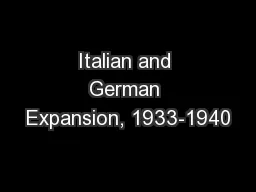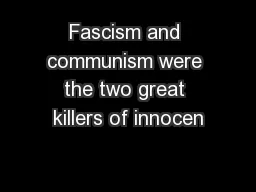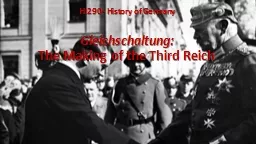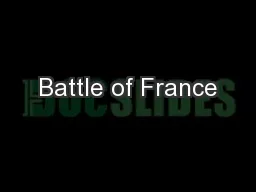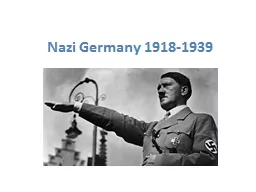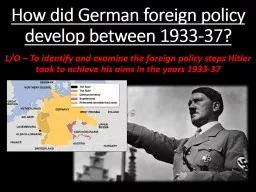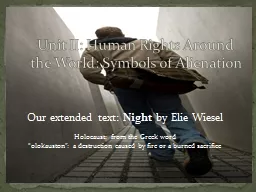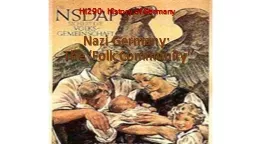PPT-Italian and German Expansion, 1933-1940
Author : tawny-fly | Published Date : 2018-09-30
Case Study 2 Italian Expansion 18701933 Italy in 1815 What appears to be the state of Italy in 1815 according to the map Italian Unification Occurs in 1861 efforts
Presentation Embed Code
Download Presentation
Download Presentation The PPT/PDF document "Italian and German Expansion, 1933-1940" is the property of its rightful owner. Permission is granted to download and print the materials on this website for personal, non-commercial use only, and to display it on your personal computer provided you do not modify the materials and that you retain all copyright notices contained in the materials. By downloading content from our website, you accept the terms of this agreement.
Italian and German Expansion, 1933-1940: Transcript
Case Study 2 Italian Expansion 18701933 Italy in 1815 What appears to be the state of Italy in 1815 according to the map Italian Unification Occurs in 1861 efforts of Cavour and Garibaldi. HI136, History of Germany. Lecture 8. The Origins of Nazism. Interwar Germany a fertile breeding ground for radical right-wing organizations.. 1919: Anton Drexler founds the . Deutsche . Arbeiterpartei. Fascism and the Totalitarian State. Benito Mussolini. Adolf Hitler. Fascism in Europe. German. Formed a totalitarian government. Invaded Ethiopia in 1935.. Italian. Anger over the Versailles treaty. :. The Making of the Third Reich. HI290- History of Germany. The Campaign for Reichstag Elections, . January – March 1933. New elections called within 24 hours of Hitler becoming Chancellor.. 31 . Jan. 1933: Hitler’s ‘Appeal to the German People’ – blamed Germany’s problems on the Communists and presented his government as a ‘National Uprising’ that would restore German pride & unity. Sofia Ramirez. , Lin Ye, Rithvik Nallapareddy, . Grant Niehaus. & Chase Raines. Hitler Jig :) . Background. Battle of France. · May 10, 1940- June 25, 1940. · Also known as Fall of France, successful German invasion of France and the Low countries. Key Topic 1. Weimar Republic. 1918-1929. November 1918. Germany loses WW1. Kaiser abdicates. Armistice signed (agreement to stop fighting). June 1919. Treaty of Versailles. G. UILT. . Germany had to accept all responsibility for the war. L/O – To identify and examine the foreign policy steps Hitler took to achieve his aims in the years 1933-37. What influenced his foreign policy?. As you have seen with Mussolini and now Hitler, foreign policy is…. Sofia Ramirez. , Lin Ye, Rithvik Nallapareddy, . Grant Niehaus. & Chase Raines. Hitler Jig :) . Background. Battle of France. · May 10, 1940- June 25, 1940. · Also known as Fall of France, successful German invasion of France and the Low countries. 5 minutes. Do Now. Rise of Totalitarianism . Hitler’s Rise to Power. National Socialist German Workers’ . Party (NAZI). Anti-communist political party formed to support the interests/needs of workers. Our extended text: . Night . by . Elie. Wiesel . Holocaust. : from the Greek word. “. olokauston. ”: a destruction caused by fire or a burned sacrifice. What can literature teach us about humanity and responsibilities to ourselves, our culture, our society, and our world?. The Economic Record . of . the Great Depression. Conditions During the Great . Depression. Large reductions in output. Soaring unemployment. Farm and home foreclosures. Bank failures. Human suffering. Burning books is not a special idea of the 20th century. Already in Antique times the destruction of the Alexandrian library became a symbol and a myth. The first recorded state-sponsored book burning was the destruction ordered by by the Grand Councillor Li Ssu in Ch‘in China in 213 BC. In the Middle Ages and the Early Modern Age the burning of books was organized by the Catholic Inquisition for writings which had been seen as heretic. The famous quotation and much-repeated warning from Heinrich Heine: „Where one burns books, one will soon burn people“ origins from his play Almansor (1821), which is set among the Moors of Spain as they endure the first attack of the Spanish Inquisition. With the Enlightment book burning became unfashionable. Maybe for this reason book burning in the 20th Century by totalitarian regimes became in some way a very symbolic action to show the antiliberal attitude and their opposition towards the Enlightment ideas. HI290- History of Germany. Volksgemeinschaft. (Folk Community). Idea of an equal community of racial comrades. Everyone’s participation. Equality defined racially and socially. Based on exclusion of those who did not fit in racially and biologically (“non-Aryans,” “. Order in-store or Order one of ourdeli sandwichesvv- vegetarian699ea A.D.LEIGHANDA.MEYERcurrentatthattimehediscussedthepossiblecausationofdiabetesbylesionsofthevermis,particularlyoftheuvula.OneofWinkelman's(1943)casesofgranularlayerdegenerationwasadiabeticwhodiedfollow
Download Document
Here is the link to download the presentation.
"Italian and German Expansion, 1933-1940"The content belongs to its owner. You may download and print it for personal use, without modification, and keep all copyright notices. By downloading, you agree to these terms.
Related Documents

